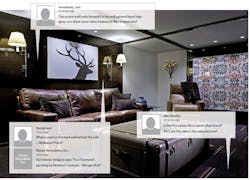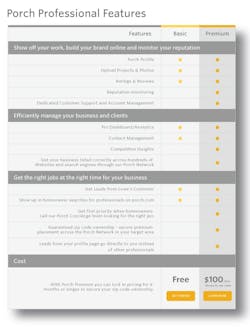Online Referral Sites Are the New Must
Attention remodelers: If you aren’t participating aggressively in an online platform such as Houzz.com or Porch.com, you need to do so. Now.
“Houzz is the Google of remodeling,” says April Bettinger, owner of Nip Tuck Remodeling, in Woodinville, Wash. Bettinger attributes $250,000 in 2014 revenue generated from Houzz leads, and says that she’s on track for the same this year.
And Bettinger is not alone.
JRP Design & Remodel, in Thousand Oaks, Calif., completed two projects in 2014 that came through Houzz-—totaling $655,000. While Keil Johnson of DJC General Contractors, in Mill Creek, Wash., says that 20 percent of his volume comes through Porch, his only paid marketing venue.
But it’s not enough to display a bunch of pretty pictures on these sites, then sit back and wait for business. Both sites take work and a some finessing to make them pay high dividends. Here are a number of tips remodelers can use to ensure that Houzz and Porch are yielding the best results possible for them.
First, a few quick words about each site.Houzz.com
Started in 2009 by a couple who were frustrated with their own remodeling experience, Houzz now hosts more than 600,000 professionals with profiles who are active on the site (the database has over 3 million profiles). The site’s popularity is phenomenal, with more than 25 million users visiting each month.
Homeowners mine Houzz for inspiration, often creating ideabooks on the site to help in their own project planning. They can get advice, buy products, and read articles about remodeling and design. Homeowners also peruse remodelers’ project descriptions and people’s comments and company reviews “as a proxy for what it would be like to work with them,” says Liza Hausman, Houzz vice president of industry marketing.
The more that homeowners know and like about a remodeling company, the more comfortable they become with the idea of hiring that remodeler and moving forward with their project.
Professionals can maintain a company profile on Houzz and
participate on a free or a paid, sponsored (Pro+) basis. Paying participants choose business specialties and specific geographic areas for their Pro+ exposure. Pro+ companies have priority placement in contractor directories for their markets, and Houzz places their project photos in the photo stream.
This finished basement photo from Master Remodelers, in Pittsburgh, garnered more than 12,000 views in one month on Houzz. The company also leverages star projects such as this in its print advertising and marketing.
Porch.com
CEO Matt Ehrlichman started Porch.com as a one-stop shop for homeowners to find, evaluate, and select remodeling and other home-service professionals. The site features information about 3.2 million home professionals in 128 service categories. Porch encompasses 130 million projects, along with maps that show locations and costs. (Remodelers can choose whether to display this information.) Through a partnership with the Better Business Bureau, Porch also displays the BBB rating for professionals on it site.
Remodelers can upload project photos and descriptions, as well as company information and advice to consumers. A dedicated phone number sends calls to remodelers while tracking them through the Porch system.
As with Houzz, professionals can participate on Porch on a free (basic) or paid (Premium) basis. Premium professionals select ZIP code areas where they wish to be featured. They pay $100 per month or more per area based on population, income level, and other demographic measures. Up to four companies in each service category can subscribe in each ZIP code. Premium benefits also include access to a dashboard of lead tracking analytics.Tips for Success
1. Post professional photos
Top-quality project photos, and lots of them, are a must. The more photos you post with your profile and the more interesting the projects they show, the more exposure, attention, and homeowner interaction your company will get. Upload as many photos as you can as often as possible.
If you include “before” photos, make sure that they are clearly labeled as such. You can position them to appear following the “after” shots to avoid confusion. Hire a professional architectural photographer to shoot the completed projects, and stage the rooms if necessary.
2. Be assertive in getting reviews
Today’s consumers heavily rely on customer reviews when making buying decisions; so don’t be shy about requesting them. Satisfied clients generally are happy to help you by posting positive feedback. Both Porch and Houzz contain features that help professionals send requests for reviews to clients. The responses go back to the website. The sites will send out a reminder in three weeks if no response has been received. Porch uses a “Verified Review” label to distinguish reviews verified to be from homeowners who worked with the professional.
Another option is to craft a template and send it out yourself. There are also third-party companies, such as GuildQuality, which provide that service.
Remodeler Bryan Sebring, of Sebring Services, in Naperville, Ill., has an impressive 62 reviews on Houzz. To obtain reviews, he requests them early and often. When the contract is signed and at job completion he asks clients to review the company. He informs clients that he will reward their project manager for a review of a job well done. (A small bonus per project per site—Houzz, Yelp., etc.). Project managers monitor customer satisfaction during the project, and Sebring asks clients to contact him directly if any problems need to be resolved. At project completion, Sebring sends clients an e-mail explaining the importance of customer feedback in the company’s online marketing and provides links they can use to submit reviews.
By managing client satisfaction throughout the project, Sebring is confident that the reviews will be positive. Houzz has a reputation management guide for professionals to help them respond to negative reviews in a polite, constructive manner.
3. Tag and code
When homeowners explore online platforms, they use search terms. Maximize the number of times your projects match the search by blanketing your photos with tags and codes. These are invisible to consumers but connect to searches they enter. With each photograph, start at one side and make your way across, adding tags for everything small and large—from product colors, materials, styles, sizes, names, and models to design features and details.
Consumers drill down to very specific details, and your anticipating that will make your photos come up on more searches.
4. Stay active, update often
Keep your company presence fresh and dynamic, uploading new project photos, arranging photos and displays for variety and interest, and revising company and project narratives. Marketing directors may spend several hours a week on their Houzz work. Randy Strothman, whose company handles Internet marketing for Master Remodelers, in Pittsburgh, says that it’s time well spent: He uses Houzz as a “satellite website” for the company.
This holds true for Porch as well. Nicole Ryback, of Synergy Builders, in West Chicago, Ill., says that on Porch, “It’s easy for people to see how many of each specific type of project a contractor has done and in what areas.” To keep that information current, Sebring’s company uses Co-Construct management software, which integrates with Porch to automatically upload new project information.
Porch.com maps show by locale the project details and cost history of work done in the area. The maps also provide information about professionals who have previously worked on homes in these neighborhoods.
5. Win awards
Each January, Houzz presents “Best of Houzz Design” and “Best of Houzz Customer Service” awards, with accompanying website badges, to professionals.
These designations are powerful marketing tools. You can boost your chances of getting them by managing your profile. Design awards are determined by how many of the company’s photos have been saved by homeowners. The more you tag, keyword, and post high-quality photos, the more saves you should see. Service awards are based on how many reviews the company has received.
Once you win, post the award badge on your website and add it to your e-mail signature and marketing materials.
6. Communicate with consumers on the site
Participate in online discussions, even if the homeowners are not in your market. You will be increasing exposure for your company and showcasing your creativity, knowledge, and industry engagement.
And if consumers ask about something in a photo—what store did the pillows came from, for instance—always respond, even if you don’t know the answer. A quick sentence or two showing friendliness, professionalism, and willingness to help can be as beneficial as actually providing the answer.
A new Porch app alerts professionals to incoming inquiries and enables them to instantly respond.
7. Put personality into your profile
Consumers get to know you through your company profile and may make a decision about your company within a few seconds of being on your page. Along with great project photos, include informative, friendly project descriptions that include something about you and the remodeling solutions you provide to your clients. Consider including photos of yourself as well. Homeowners will feel like they know you before you arrive for an initial consultation.
8. Track your account activity
Many remodelers report excellent results with paid participation on the Houzz and Porch networks. Combined with a well-managed site presence, the premium exposure provided to paid subscribers has yielded an eye-popping number of hits and leads. Infinite Home, in Suwanee, Ga., for instance, drew 1,500 hits in one month last year, says Laurel Mullikin, the company’s co-founder. Since upgrading to paid status a year ago, Ryback has garnered more than 50 leads, all but five of them qualified.
But the most important thing is the strength of your page and site participation. Tracked data tells the story. Kristina Ferrigan, director of marketing for Normandy Design Build Remodeling, in Hinsdale, Ill., says that Normandy augmented its free Houzz profile with paid status for a year. When Houzz account representatives reviewed the remodeler’s robust site presence and performance data, they told Ferrigan that most of the benefit came from Normandy’s hard work supporting the company’s free profile. After analyzing the data, Ferrigan came to the conclusion that the paid status wasn’t necessary for her company’s profile. (Remodelers can request a free profile consultation at support.houzz.com.)Washington state contractor Keil Johnson values the dedicated Porch phone line that channels callers to his company. He says it’s primarily used by homeowners, so it functions as a tool to track site performance. Porch’s Pro Analytics Dashboard shows additional data to help him manage his Porch activity.
9. Listen to the site experts
Paid or free, you can find expert support on Houzz and Porch. Take advantage of it. Remodelers say that the analysis, evaluations, ideas, and suggestions from site representatives are spot on. Listen to the advice and follow it.
10. Work with ideabooks
Remodelers work collaboratively with clients via online ideabooks (Houzz) or scrapbooks (Porch), which function as electronic scrapbooks where clients can collect and store ideas. Early in the project planning process, you can ask to review your client’s ideabooks to get a sense of their taste, style, and wishes. Ferrigan says that Normandy designers also may create Houzz ideabooks for clients as a way to suggest ideas and share their vision for the project.
Design/build remodeler Michael Sauri, president and co-owner of TriVistaUSA, in Arlington, Va., uses ideabooks to zero in on clients’ design preferences. He asks them to sign up for a free Houzz account and assemble an ideabook with no more than 10 photos. Homeowners enter private comments identifying which seven or eight photos they love and which two are examples of what they don’t like. “It makes them focus,” Sauri says. “There’s always one image that really speaks to them, and the whole project design may revolve around that image.” PR





